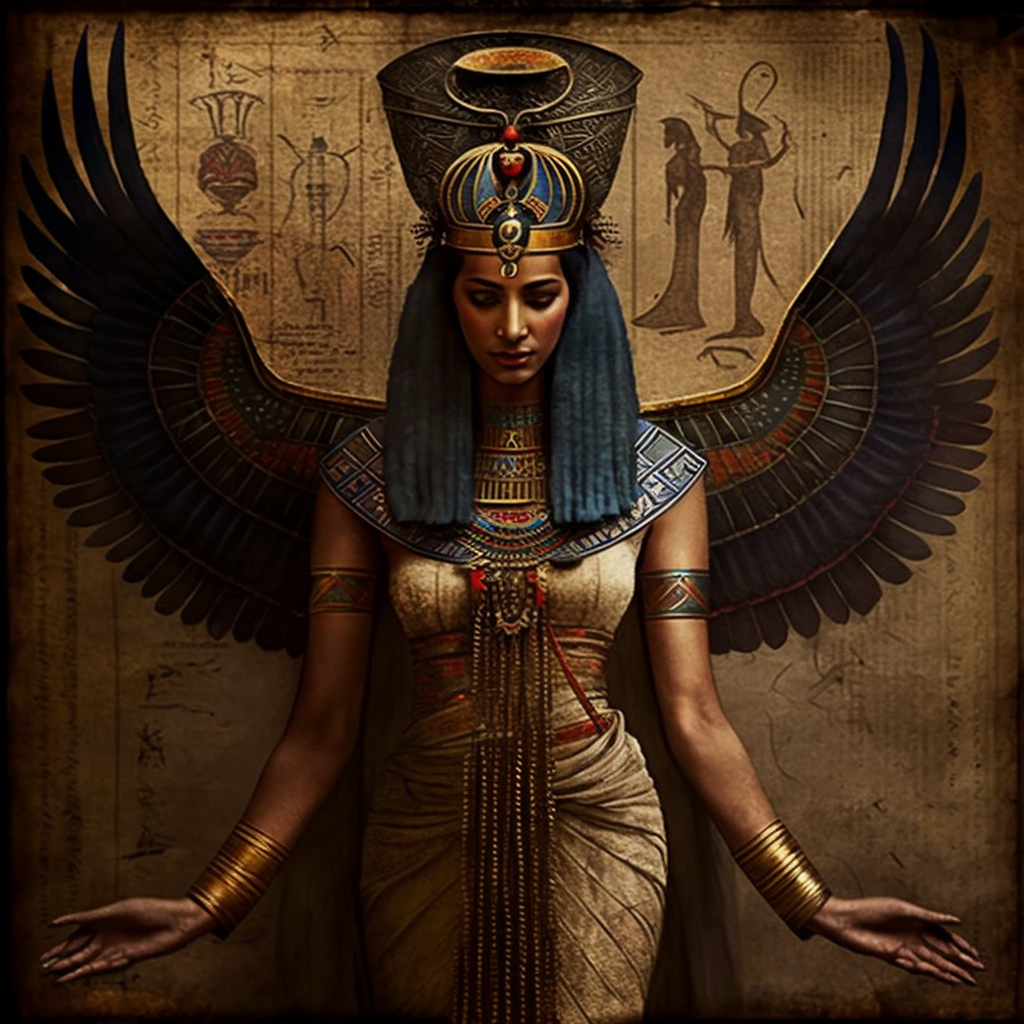Mut, “Great Mother, Lady of Heaven, Queen of the Gods”
Mut is an ancient Egyptian deity associated with motherhood, fertility, and the protection of the royal family.

- Pantheon: Egyptian pantheon
- Deity Title: Great Mother, Lady of Heaven, Queen of the Gods
- Deity Symbol: Vulture or the Double Crown of Egypt
- Home Plane: The Celestial Nile
- Deity Level: Greater deity
- Alignment: Lawful Good
- Aliases: Ammit, Sekhmet, Bastet
- Superior: None
- Traditional Allies: Isis, Hathor, Osiris
- Traditional Foes: Apophis, Set, Apep
- Divine Artifact: Scepter of Power
- Servants: Vulture spirits, lion spirits, sacred ibises
- Servitor Creatures: Griffins, sphinxes, androgynous servants
- Sacred Animal: Vulture
- Manifestations: Golden light, vulture feathers, soothing voice
- Signs of Favor: Healing, fertility, safe childbirth, protection from harm
- Worshipers: Mothers, women, pharaohs, royal families, healers
- Cleric Alignments: Lawful Good, Neutral Good
- Specialty Priests: Divine protectors, midwives, physicians, advisors to royalty
- Holy Days: Wep Ronpet (New Year), Opet Festival (celebrating the pharaoh’s divine birth), festivals in honor of other gods
- Portfolio: Motherhood, fertility, protection, leadership, royal power
- Domains: Good, Healing, Law, Protection, Strength
- Favored Weapon: Scepter
- Favored Class: Cleric
- Favored Race: Human
- Duties of the Priesthood: Care for the temple and its rituals, provide guidance to followers, protect the pharaoh and the royal family, heal the sick and injured
- Major Cult/Temple Sites: Karnak Temple Complex in Thebes, Temple of Mut in Luxor
- Benefits: Divine healing, protection from harm, guidance in matters of state, enhanced leadership abilities, ability to summon sacred animals
Mut is an ancient Egyptian goddess, revered as a mother figure and a symbol of feminine power. She is often depicted as a vulture or a woman with the crown of upper and lower Egypt, highlighting her connection to royalty and motherhood. As a divine protector, Mut watches over the pharaohs and their families, shielding them from harm and offering guidance in times of need.
In her role as a mother goddess, Mut is compassionate and nurturing, embodying the ideal of maternal love and care. She is also known for her strength and resilience, able to withstand even the most difficult challenges with grace and determination.
Despite her divine status, Mut is not content to simply sit on her throne and bask in her power. She is driven by a desire to make the world a better place, to ensure that all living beings are treated with kindness and respect. Through her actions, she hopes to inspire mortals to live up to their own potential, to tap into their inner strength and compassion in order to create a more just and equitable society.
To achieve this goal, Mut encourages her followers to cultivate a sense of empathy and understanding, to see themselves in others and work together to overcome the obstacles that divide them. She also promotes the value of self-reflection and introspection, encouraging individuals to examine their own biases and prejudices in order to become more open-minded and accepting of others.
Mut is typically depicted as a woman with the crown of upper and lower Egypt, adorned in regal attire and carrying a scepter or ankh. She has a human body but is often shown with the wings of a vulture, highlighting her connection to this powerful bird. Her features are usually serene and dignified, with a gentle smile and an aura of maternal warmth.
Overall, Mut is a complex and multifaceted deity, embodying the best qualities of both motherhood and leadership. Through her guidance and example, she inspires us all to be our best selves, to embrace our own power and potential in order to create a brighter, more compassionate world.
Currently
Mut, the great mother goddess of ancient Egypt, has watched with sadness as the world around her has changed. The once-mighty pharaohs have fallen, replaced by new rulers who do not hold her in the same reverence as their predecessors. Her temples, once the center of the religious and political life of the land, have fallen into disrepair, their walls crumbling and their priests scattered.
But Mut is not one to give up in the face of adversity. She knows that her power is not derived from the bricks and mortar of her temples, but from the devotion and faith of her followers. And so she has turned her attention to the world beyond Egypt, seeking out new believers and spreading her message of love and compassion.
In the 1450s, Mut has taken a particular interest in the burgeoning European empires, who are spreading their influence across the globe in the name of commerce and conquest. She has watched with dismay as these newcomers have subjugated and enslaved the native peoples of the Americas, treating them as little more than commodities to be bought and sold.
With a heavy heart, Mut has decided to take action. She has begun to whisper in the ears of the few Europeans who are sympathetic to her cause, urging them to speak out against the atrocities being committed in her name. She has also sent emissaries to the Americas, hoping to spread her message of love and unity to the oppressed peoples there.
Mut knows that her efforts may seem small in the face of such overwhelming cruelty, but she is undaunted. She believes that even a single act of kindness or compassion can make a difference in the world, and she is determined to do everything in her power to make that difference.
As she watches the events of the world unfold, Mut remains steadfast in her mission. She knows that the road ahead will be long and difficult, but she also knows that she has the strength and wisdom to see it through. And so she continues on, ever vigilant and ever hopeful, in her quest to make the world a better place.

 Buy me a coffee
Buy me a coffee